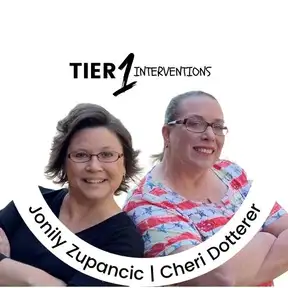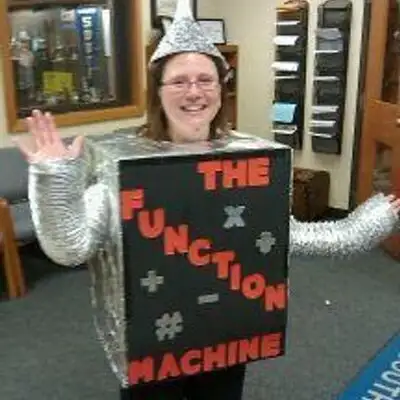
Rethinking Math Education Part 4: S2 E27
Speaker 4: Hey everybody!
Welcome to Tier 1 Interventions,
where we work on helping you
gain the core in your classroom.
I am Cheri Dotterer, your classroom coach.
That's Cheri with a C
and Dot with a stutter.
I'm here today with Jonily Zupancic,
your instructional coach on mathematics.
And we are here to help learn, help
you learn how to deliver your math
instruction in a very unique way.
Today we are going to talk
about the pain problem.
Jonily
Speaker 6: get us started!
Hey everybody.
I'm Jay-Z.
Jay-Z in the house, Jonily Zupancic and
Tier one Interventions is, as Cheri said,
strengthening your core regular classroom.
So this is for specifically the
classroom teacher, partnering with the
intervention specialist, instructional
coach, curriculum leader, principal.
Special Service Provider, Occupational
Therapist, Speech Therapist.
How can kids get exactly what they need in
the Tier 1 Core Regular General Classroom?
Too often we have kids leaving the
room to be pulled out for small
group Tier 2 or Tier 3 intervention.
Speaker 11: Last week, we stopped
the video when John Lee asked why.
Let's tune in this week and
find out how I answered.
Speaker 6: And then he, for the next
10 minutes, was so focused and engaged
and in tune and working independently.
See, focus, a focus trigger for
him, he's got to spin and jump.
Then he can attune to the task.
And he was listening
to every word you said.
Why?
Speaker 4: Why, Cheri?
Because he was shifting his brain the
way he knew how to make attention.
The movement was turning off
parts of his brain that he needed
so that he could auditorily
understand what you were saying.
If you would have just had him sitting
there, his brain would have been, I need
to spin, I need to spin, I need to spin,
and that's all his brain would have heard.
It would have never heard.
The stuff that you were trying
to tell him by spinning that
part of his brain was occupied.
So the other part of his brain could work.
Speaker 6: And so in typical traditional
school setting, we make everybody sit, we
make everybody look at us with their eyes.
We make everybody comply.
And the three or four kids that
Look like they're listening.
We explain all the directions
and we release them.
And then you get the, what are we doing?
Oh my gosh, I just told you.
The way that you were making them
comply when you were explaining
negated the whole phrase that you said.
Now I can't have 17 kids up
and spinning and acting a fool.
But you've got 2 or 3.
And they might need to do this.
As we're giving directions, because
nothing frustrates a teacher more
than when we explain all these
directions so articulately, and then
five kids are like, what are we doing?
So then we release them
and then we get frustrated.
Then learn how to teach
and explain directions.
So why can't the whole classroom
Speaker 4: do spinning activity?
Why can't they stand next to their desk,
do an activity that's controlled by the
teacher that increase, that facilitates
movement, that facilitates proprioception,
that facilitates the interoception and the
vestibular systems as well, so that for a
short amount of time, they're all engaging
in that and then do the instruction.
And that is what I've been
preaching for the last two years.
Speaker 6: Janet, what are you doing?
You're giving us video.
Explain to us.
Janet, you teach 7th grade.
Talk to us.
Speaker 10: Yeah, I see a lot
of, I have two standing tables.
I have one standing
table that's on wheels.
And this one kid goes back and
forth because he can't sit.
I've got a yoga ball and
our chairs naturally rock.
And they're all, woo!
And I still have to do the crazy eight.
I don't know if I call it crazy yet.
I call it whatever we need to refocus.
I'll have them push against the ceiling.
I'll say we'll do an
upside down handstand.
And I tell them to push harder because,
I'm a lot heavier than they are.
And then they cross their hands
and we make an eight with our arms.
And then I'll have them do their name
in cursive because that's just funny.
And they giggle because they like,
Don't know how to do cursive.
And we're all just going,
ah sometimes I do angles.
I'll say, give me a, cute angle.
And then I'm like, give
me a straight angle.
And then we'll do vertical angles
because that's all part of the
seven gate curriculum and they
don't tend to remember them.
So we just keep doing
it over and over again.
And it also helps us refocus.
And I sneak those extra
experiences in there.
Love
Speaker 6: it so much.
And what's interesting is those are
examples again of focus triggers and a
couple that you mentioned cross midline.
Now, I did one yesterday
on the kindergarten audio.
I was very intentional and deliberate
in this kindergarten class because I
wanted to put as much in there that
people could analyze as possible.
So when we were transitioning from
one thing to another and I wanted.
Everybody's attention, and
I wanted all eyes on me.
I don't always want this, but I
wanted it because we were going to
do something a little more complex.
Now, my expectation is I want everybody
looking at me, and I want everybody
listening, but my expectation is I know
there's going to be five or six kids
that aren't going to know what I'm doing.
After I say it anyway, and as
long as we have that expectation
when we do that's fine.
The reason I wanted everybody focused is
I put pencils down and we wiggled fingers
because I wanted to transition their
brain to another topic, to another skip
counting number, to a different shape.
And I said, okay, wiggle your fingers
and I waited for everyone's attention.
We touched ears.
Opposite ears, opposite ears.
And we did that five or six times.
And what that does is it
just, it's a focus trigger.
It crosses midline.
It gets everybody in tune.
And then I can tell them
we're switching gears.
The brain is ready now for a next step.
These subtle focus triggers, there are
so many categories of them, and there are
so many simple things that you can do.
Cheri's handstand flip
that Janet mentioned.
These are all specific focus triggers
that will re engage and refocus students.
at any time.
Speaker 3: I also wanted to make
a point that you may be finding
some kids who can't transition
from the board to your table.
So those are the kids you're
going to have to watch for that.
If you're doing something
at the board now, I know you
brought them closer to you.
You may have picked up on some of the
kids that was good to have the paper
and give it to them because those are
the kids that can't go up and down.
It's vestibular.
Also I been finding a lot of kids
lately that have really a lot of trouble
with tracking and those are the kids
you're going to find that maybe can't
go across your one 20 chart and are
going to need to have the use their
finger or a pointer going across.
So you're going to have to
watch where their head in an
alignment kind of thing goes.
Speaker 12: There is so much more
to mathematics than meets the eye.
It's not just computation.
There is so much cognitive aspect
going on that's why we bring you these
episodes of tier one interventions so
that you can learn how complex the mind
is as it's working through the math.
Kids that are struggling have
difficulty making those connections.
I hope you turn in next week to hear our
next episode of Tier 1 Interventions.
Until then, make sure that you click that
subscribe button, leave a comment, and
share this with five of your friends to
let them know that we are out there and
we are hoping that this is helping you
understand what's happening behind the
scenes, as they say, or in the brain.
With tier one interventions
Speaker 13: and
Speaker 12: how do we keep our classrooms
coherent, even working alongside the
related service provider or other
professionals and paraprofessionals
that are working the classroom.
See you next week on
Tier one Interventions.
Episode Video
Creators and Guests


